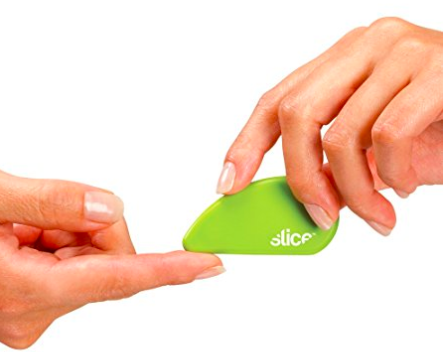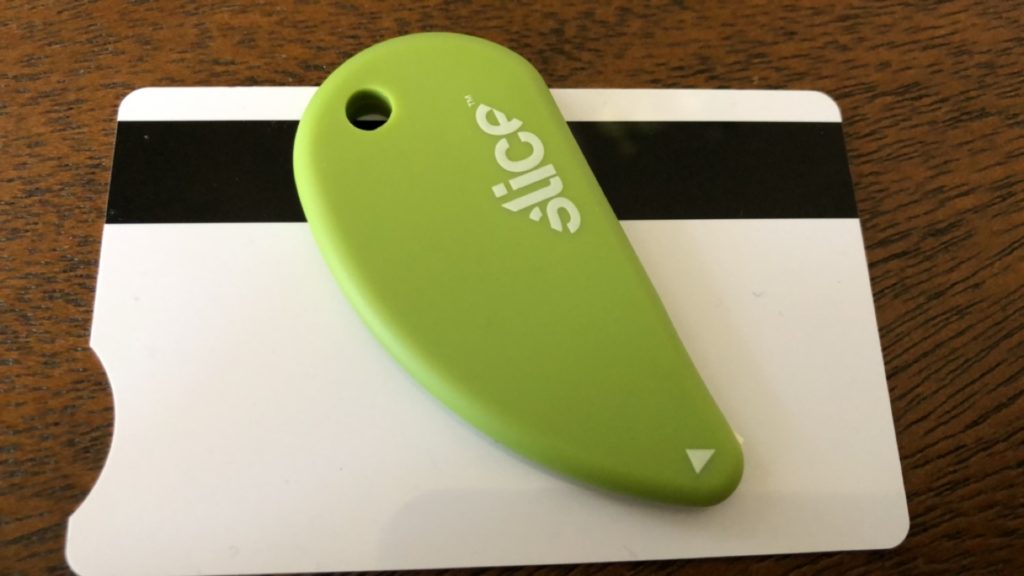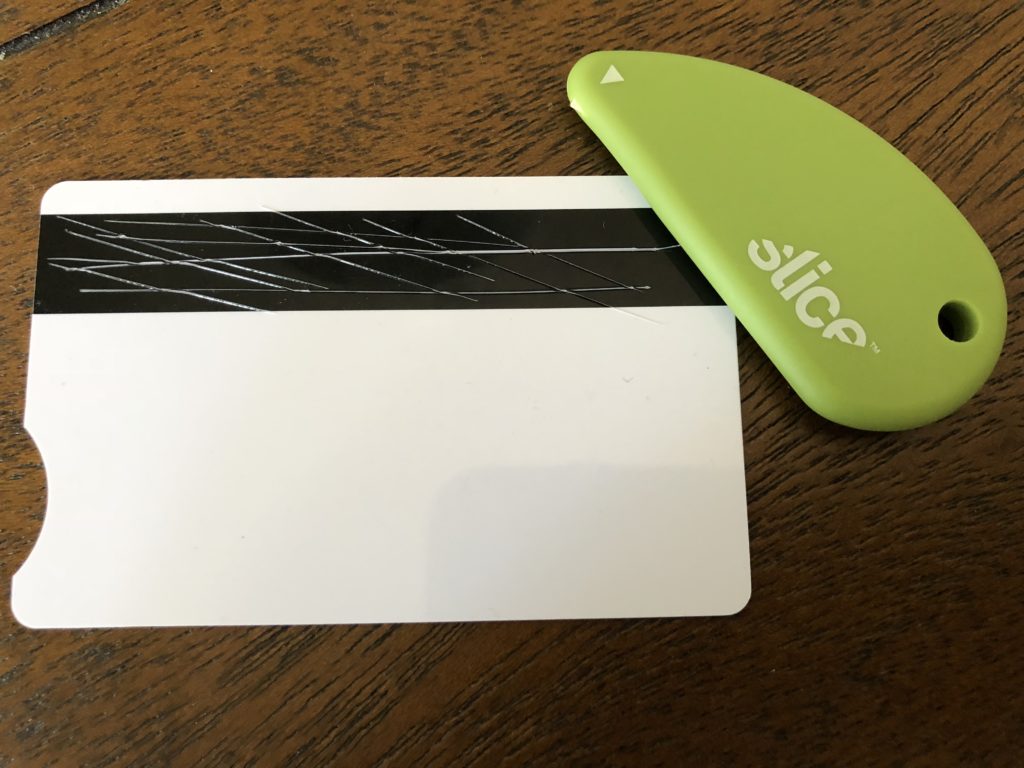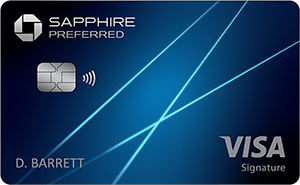We may receive a commission when you use our links. Monkey Miles is part of an affiliate sales network and receives compensation for sending traffic to partner sites, such as CreditCards.com and CardRatings. This relationship may impact how and where links appear on this site. This site does not include all financial companies or all available financial offers. Monkey Miles is also a Senior Advisor to Bilt Rewards. Terms apply to American Express benefits and offers. Enrollment may be required for select American Express benefits and offers. Visit americanexpress.com to learn more Opinions, reviews, analyses & recommendations are the author’s alone, and have not been reviewed, endorsed or approved by any of these entities.
Several months ago I was seated next to the founder of Slice, TJ Scimone. We got to talking about travel, points, and long story short – he sent me a suite of products to try out. Slice features a safe ceramic blade that somehow doesn’t cut your finger, but is sharp and durable enough to cut a lot of other things. I gave their TSA approved Cutter a try, and have been really pleased with it every since. Earlier this year, I was interviewed by the website ( the entire interview is copied below), but since it’s a product I use, and have found value adding to my carry on, I thought it worthwhile to highlight.
The Cutter is super small, fits in a small pocket of my backpack and easily cut through the back of hotel key cards, shrink wrapped amenity kits, etc. The best part, it easily passes through TSA check points, and is super cheap ( like 6-7 bucks on Amazon). Here’s an affiliate link via Amazon to the exact model I carry:
 And what you should all be doing with your hotel key cards ( they carry TONS of personal info and you should NEVER leave them in your room) is what I primarily use this travel companion for – destroying the magnetic strip of key cards. Amazingly, it cuts right through those strips with very little pressure, yet doesn’t rip the inside of my bag, nor cause any cuts or scratches.
And what you should all be doing with your hotel key cards ( they carry TONS of personal info and you should NEVER leave them in your room) is what I primarily use this travel companion for – destroying the magnetic strip of key cards. Amazingly, it cuts right through those strips with very little pressure, yet doesn’t rip the inside of my bag, nor cause any cuts or scratches.
Here’s a republication of the SLICE article that I was interviewed for earlier this year. Check it out – lots of interesting tidbits.
TSA-Approved Pocket Knife? No, But this Slice Cutter Can Fly

Many an airline traveler has made the mistake of thinking that they had a TSA-approved pocket knife or other cutting tool they could get through security. Or maybe they thought no one would notice that giant saber in their carry-on bag.
This has led to numerous highly entertaining posts in the TSA Instagram feed (there are also many images of animals who have gone through security, including two penguins and an eagle!).
The feed documents some of the obviously banned sharp items and weapons that passengers have tried to bring with them to their seat. These hopeful, or unknowing, passengers have contributed to what is likely now a huge TSA pocket knife collection.
Anyone who’s gotten on a plane in the United States since 9/11 knows that rules are strict regarding what you’re allowed to bring in your carry-on bag. And with most airlines charging for checked baggage, many people are choosing to bring all their belongings with them on board. This greatly limits what they can travel with.
So, What Can I Bring on an Airplane?
The answer to the question, “Can you carry a pocket knife on an airplane?” is always no. Absolutely not. The TSA makes it very clear what you can and can’t bring on the plane with you. Knitting needles, sure. Your favorite knife hidden in a comb? Come on now. There are many TSA-approved pocket tools, including several handy multi-tools, but nothing that is sharp.
Uncertain about a particular item? Tweet the TSA a photo of what you’d like to bring, and they’ll get back to you right away to let you know if it’s OK. But remember, it is always left to the discretion of the agents who are checking your baggage as to whether or not they’ll confiscate a questionable item.
If you believe there’s a possibility the TSA may not approve of everything in your bag, bring a pre-stamped and pre-addressed envelope large enough to hold the item you’re unsure about. You can either address it to where you’ll be staying, or to your home.
Since There’s No TSA-Approved Pocket Knife, Are There Any TSA-Compliant Tools That Cut?
Cutting tools are, by their very nature, sharp. This is what the TSA has to say on the subject: “In general, you are prohibited from traveling with sharp objects in your carry-on baggage.”
But you love the convenience of having a tool that cuts things. And you also refuse to pay for a checked bag, which you then have to wait for on the other end, if it hasn’t already been sent off to Tahiti while you watch the airport baggage-go-round in Guatemala.
One of the only TSA-approved tools that cuts is any pair of scissors with blades that are less than four inches long (measuring from the pivot point). We can now add to that list the small but mighty Slice Safety Cutter, which features a ceramic microblade.
The Slice Safety Cutter: Not Joining the TSA Pocket Knife Museum

The blade on the Safety Cutter is so tiny that it’s likely to go unnoticed. It certainly isn’t going to cause any danger to fellow passengers, or to yourself. And it features the proprietary finger-friendly® grind found on all Slice blades.
But what can this itsy-bitsy number possibly do? Zachary Abel, the man behind the monkey in the popular travel blog Monkey Miles, has found many convenient uses for this safe tool while on the road and in the sky.
“It’s great for cutting off luggage tags and museum wristbands, and opening airline-provided amenity kits,” says Zachary. “I used to have to use fingernail clippers”—these being one of the only other TSA-friendly tools for cutting. Zachary also points out that he uses the Safety Cutter to cut through the magnetic strip on his hotel key cards: “I always do this because it has all of your personal information on it,” he says (thanks for the tip, Zachary).
Zachary racks up thousands of sky miles, so he’s had some practice with the Safety Cutter on the go: “It’s even fine to take on international flights,” he states. He adds that, overall, he’s been really surprised by how effective and useful this tool is.
The Safety Cutter will also do the trick on the plastic shrink wrap used to protect kids’ car seats, luggage, and other checked items, as well as the hard plastic packaging around your new favorite souvenir. And it’s handy for opening envelopes and getting through packing tape.

Some additional features make the Safety Cutter an easy travel companion. It’s small and light, and it features a hole so you can keep it on a keychain or lanyard. The microblade means you don’t have to be concerned about nicking yourself while rummaging around for it in a bag or pocket.
It’s also magnetic, so you can keep it on the fridge if need be. The surface is textured to allow a no-slip grip, and it’s ergonomically designed to fit naturally in the hand, so it’s easy to use.
Cut and Run: Now There’s No Need to Test TSA Pocket Knife Rules
While you may long to bring your favorite Swiss army knife on your European holiday, here’s one more reason to be happy about leaving it at home: now you have a cutter that can get through the red tape and to your destination worry free. There’s simply no need for a TSA-approved pocket knife with the Safety Cutter in your bag.
Opinions, reviews, analyses & recommendations are the author’s alone, and have not been reviewed, endorsed or approved by any of these entities.




The responses below are not provided or commissioned by the bank advertiser. Responses have not been reviewed, approved, or otherwise endorsed by the bank advertiser. It is not the bank advertiser's responsibility to ensure all posts and/or questions are answered.